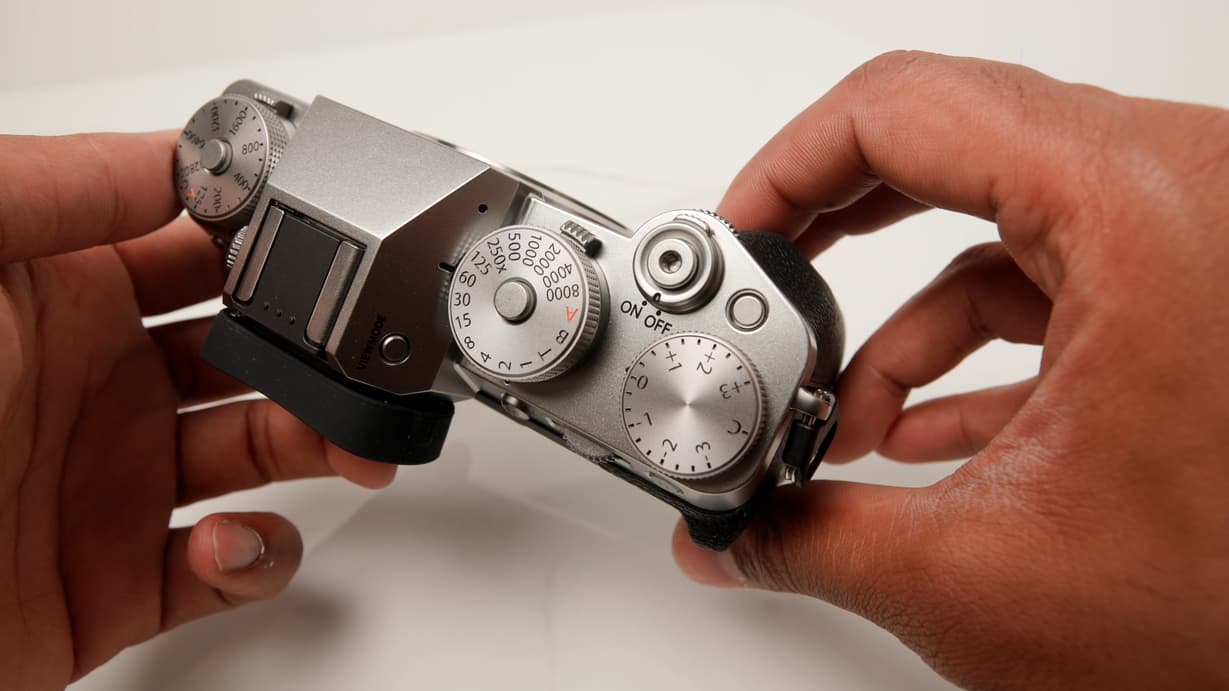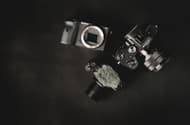The New Fujifilm X-T5 Exclusive First Look
The X-T5 delivers a vintage handheld feel with even more stunning results than its predecessors — a testament to Fujifilm's promise to quality.
The X-T3 marked a turning point for Fujifilm, where the combination of features inside a retro-inspired body made for a powerful creative tool. Moving between fantastic photography and 4K60P video in a noticeably small kit meant remarkable power to level up your work. And while some may believe that the X-T4 wasn't enough of an upgrade — the latest and greatest Fujifilm X-T5 confidently feels like a return to form.

Fujifilm
X-T5 Mirrorless Camera
Eyeing a new camera? The Fuji X-T5 camera features cutting-edge technology to produce stunning results with 40mpx resolution, familiar dials, and a great IBS
Buy for $1,699.00
The Design and Details
The Fujifilm X-T5 is designed to be taken everywhere. This one is smaller than its predecessor but offers a slightly more pronounced grip, where your middle finger has a more defined resting position. The X-T series is known for retro styling inspired by past cameras, which I love because it's conducive to comprehending photography with greater intention. The dials and lens create an exposure triangle and deepen your photographic experience; shutter speed, ISO, and aperture are all at your fingertips.
The viewfinder is a 3.69M dot OLED display with up to 100FPS refresh rate. Coming from the Fujifilm X-H2 with its 5.76M dot display, this feels like a noticeable downgrade. I would have loved to see the same viewfinder since it is a photography-centric device, though — it all comes down to the price point. With the Fujifilm X-T5, it's no surprise that some concessions will be made from the X-H2 to meet a more aggressive street price.
Moving to the back of the camera, you have a row of buttons on the top: delete, playback, AF ON, and the quick menu. The back radial dial can be customized for a shortcut. However, the front dial cannot be assigned a shortcut but may change in a later update. Furthermore, the view mode button can now be given a different shortcut should you want to use it for something else.
Returning to the back of the camera, you have the AE lock button, a joystick (not a disc!), four-way directional buttons, and your display button. This camera has numerous physical buttons, and Fujifilm could've simplified this user experience. Though I appreciate how many users will like the granularity these controls bring them. The Fujifilm X-T5 provides a ton of customization with the buttons available, making it something that users can tweak for their stylistic preferences.
One BIG change is the return to a 3-way tilting LCD. Gone is the flip-screen from this model that many YouTubers want you to believe is required on every camera. I love that this series goes back to the traditional style that makes operation at low or high angles much more accessible, where your eyes no longer have to be down and away from the camera's center.
The Fujifilm X-T5 uses up to two SD UHS-II card slots, and the NP-W235 battery was introduced with the Fujifilm X-T4 two years ago. Looking at connectivity, you have WiFi and Bluetooth as expected, along with a mic, remote, USB-C, flash-sync, and micro-HDMI port. I would've loved to see a full-size HDMI port, but I can understand that camera's target audience couldn't care less.



The Fujifilm X-T5 makes for a darn good photography adventure.

Sample Image by Gajan Balan.
For Photographers
The Fujifilm X-T5 inherits the 40.2MP high-resolution sensor of the X-H2, a practical promotion that entices anyone to ponder an upgrade. Fujifilm has worked hard to improve this sensor's dynamic range and noise performance, which was tinkered with to perfection. It also implies that users will get more resolution but a similar noise response to the X-T4. That said — noise isn't bad when you have a manufacturer that can do it specially. The higher-noise images here feel less digital and have an organic feel that won't ruin your low-light shots.
The autofocus has also received a significant update from the X-H series that performs incredibly well for eye, face, and subject detection. With some intention, you can select the best option for what you're capturing, and the autofocus keeps up with some of them.

The Best Entry-Level Digital Cameras for Photographers
Upgrading from your smartphone camera? Look no further, as our list provides the most comprehensive cameras for beginner creatives wanting to up their skills.
Getting to ISO 125 is also valuable in the studio when you're looking to maximize your image quality for client work. You can shoot as fast as 15FPS with the mechanical shutter or 20FPS in electronic mode. And the upgraded image stabilization system makes for 7-stops of stabilization on Fujifilm's modern lenses. If you have the patience or your subject allows for it, there's the 160MP pixel-shift mode to produce vast files. Whether it's fine art, archiving, or film scans, this can prove valuable later in your journey.
You take this sensor and its processor, and add the 19 film simulations and wildly customizable profiles, you suddenly have this formidable creative tool in a photo-centric package that is well under 600g with a battery. That’s nuts!

Sample Image by Gajan Balan.
For Videographers
The Fujifilm X-T5 can record 6.2K footage at 30P in a widescreen format; if you drop to 4K, it's 60P recording. The oversampled recording up to 30P will be valuable for most users, especially for voice-over or interview work. One thing to note is that the video quality caps at 4:2:2 10-bit at 360MBps. The bit rate here is lower than the X-H2, but if this is a pain point for you, you probably need to get in the market for a camera like this. That's why the X-H series exists.
While you can record in the fantastic Eterna film simulation for a great result out of the camera, if you're going to be editing and grading your footage on a computer, you'll want to take advantage of F-Log or F-Log2, which has a base ISO of 500 and 1000 respectively. F-Log2 will give you about 13+ stops of dynamic range in the field but may require an ND filter to cut the light and a bit of noise reduction in post-production, which is handled quickly. Going to F-Log loses a stop of dynamic range but may be valuable for indoor environments.
What's also wild for a camera of this size and nature is that you can record in ProRes or BlackMagic RAW via HDMI. I've been using Fujifilm cameras for over five years, and that's still wild to me, but here we are. The RAW footage is pretty awesome, and you can also expect about 13 stops of dynamic range here. I haven't seen the RAW video format as valuable as using F-Log from a workflow standpoint, where the increase in file sizes nets you an equal upgrade in visual quality. But the structure is here for those that need it in their workflow.
There are also other notable upgrades for this X-T5 concerning video: five-axis digital image stabilization, subject detection in movie modes, up to 2x digital zoom, a focus meter assist, recording frame indicators, flicker-less shutter speed, and more!
The Fujifilm X-T5 is a powerhouse video solution for most creatives that sit a little below full-time video work. Suppose you're experimenting with video, incorporating it into your photography, or want something that can level up your YouTube work. In that case, this will bring value objectively and measurably.

Where Does This Land?
Fujifilm asserts that this is photo-first camera, and they're correct. It's a fantastic photography tool that incorporates many upgrades they ushered over the year in their X-H series. With the inclusion of powerful video features, users can expect a versatile hybrid solution built for photography, but also adapts well to video. If you're a video-first creator, this is not your first option, but having some may pair nicely with another Fujifilm camera is excellent.
Diving deep into this camera and using its in-camera adjustments to build out recipes is a rewarding journey that becomes more enjoyable as you grow as a photographer. Add the weather resistance and incredibly well-tested shutter, and you have a camera built for the long run.
This camera shoots stellar images, captures rich video with proven results, and is built to last. The Fujifilm X-T5 competes with the best without even breaking a sweat. Factor in that this camera sits at $1699, and you've got something compelling for many creators to upgrade.

Closing Thoughts
I was fortunate enough to test this camera with the new XF 30mm F2.8 Macro lens that Fujifilm has announced, making a delightful experience these last two weeks.
Concerning the lens, I expected to like it less than I did. It was quick to focus, let you punch incredibly close to subjects, and performed decently well in the streets.
All in all, the Fujifilm X-T5 is a reminder of why Fujifilm is such an excellent company. It delivers that same magic a camera as the X100V brings to the table, where the past informs the future. It's not just about the looks; it's about the experience. The Fujifilm X-T5 makes for a damn good photography adventure. With the massive upgrades under the hood, this camera will undoubtedly reward creators with stunning results.

Fujifilm
X100V APS-C Digital Rangefinder Camera
Looking for that perfect street photography camera? The Fujifilm X100V is the perfect compact camera for you with its 23mm lens and great autofocus
Buy for $1,399.00





